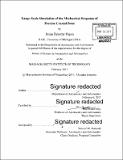| dc.contributor.advisor | Raúl Radovitzky. | en_US |
| dc.contributor.author | Fagan, Brian Timothy | en_US |
| dc.contributor.other | Massachusetts Institute of Technology. Department of Aeronautics and Astronautics. | en_US |
| dc.date.accessioned | 2017-05-11T19:55:54Z | |
| dc.date.available | 2017-05-11T19:55:54Z | |
| dc.date.copyright | 2017 | en_US |
| dc.date.issued | 2017 | en_US |
| dc.identifier.uri | http://hdl.handle.net/1721.1/108923 | |
| dc.description | Thesis: S.M., Massachusetts Institute of Technology, Department of Aeronautics and Astronautics, 2017. | en_US |
| dc.description | Cataloged from PDF version of thesis. | en_US |
| dc.description | Includes bibliographical references (pages 101-104). | en_US |
| dc.description.abstract | Biofidelic computer models are an invaluable tool in the understanding injury biomechanics. One crucial feature of these models is the ability to accurately capture the response of the individual tissues comprising the anatomy under study. In this thesis, we presented a simulation-based approach to describe the stress-strain response of cranial bone in mammals that can be applied to animal studies for model validation purposes as well as in human head injury studies. First, we explicitly characterized a microstructure specimen by generating large biofidelic meshes from [mu]CT images provided by the U.S. Army Research Laboratory (ARL). These meshes capture the intricate structures of the specimen for the model of cranial bone. In addition, different constitutive models were considered to describe the stress-strain response of the constituent cranial bone. Large-scale parallel finite element simulations were conducted and compared to experimental results of uniaxaial compression tests of cranial bone of adolescent Göttingen minipigs also conducted at ARL. The experiments show a significant amount of strain localization at different global strain levels, while exhibiting an apparent full elastic recovery upon unloading. Based on the experimental observations, it was found that an elastic hyperfoam model is an excellent candidate for describing the constituent material response. A detailed finite element model using the hyperfoam model for the constituent was able to capture both the stress-strain response and strain localization observed experimentally. The validated full-resolution simulations developed provide the pathway to develop homogenized constitutive models for cranial bone based on microstructural parameters that can be characterized experimentally. | en_US |
| dc.description.statementofresponsibility | by Brian Timothy Fagan. | en_US |
| dc.format.extent | 104 pages | en_US |
| dc.language.iso | eng | en_US |
| dc.publisher | Massachusetts Institute of Technology | en_US |
| dc.rights | MIT theses are protected by copyright. They may be viewed, downloaded, or printed from this source but further reproduction or distribution in any format is prohibited without written permission. | en_US |
| dc.rights.uri | http://dspace.mit.edu/handle/1721.1/7582 | en_US |
| dc.subject | Aeronautics and Astronautics. | en_US |
| dc.title | Large-scale simulation of the mechanical response of porcine cranial bone | en_US |
| dc.type | Thesis | en_US |
| dc.description.degree | S.M. | en_US |
| dc.contributor.department | Massachusetts Institute of Technology. Department of Aeronautics and Astronautics | |
| dc.identifier.oclc | 986241594 | en_US |
